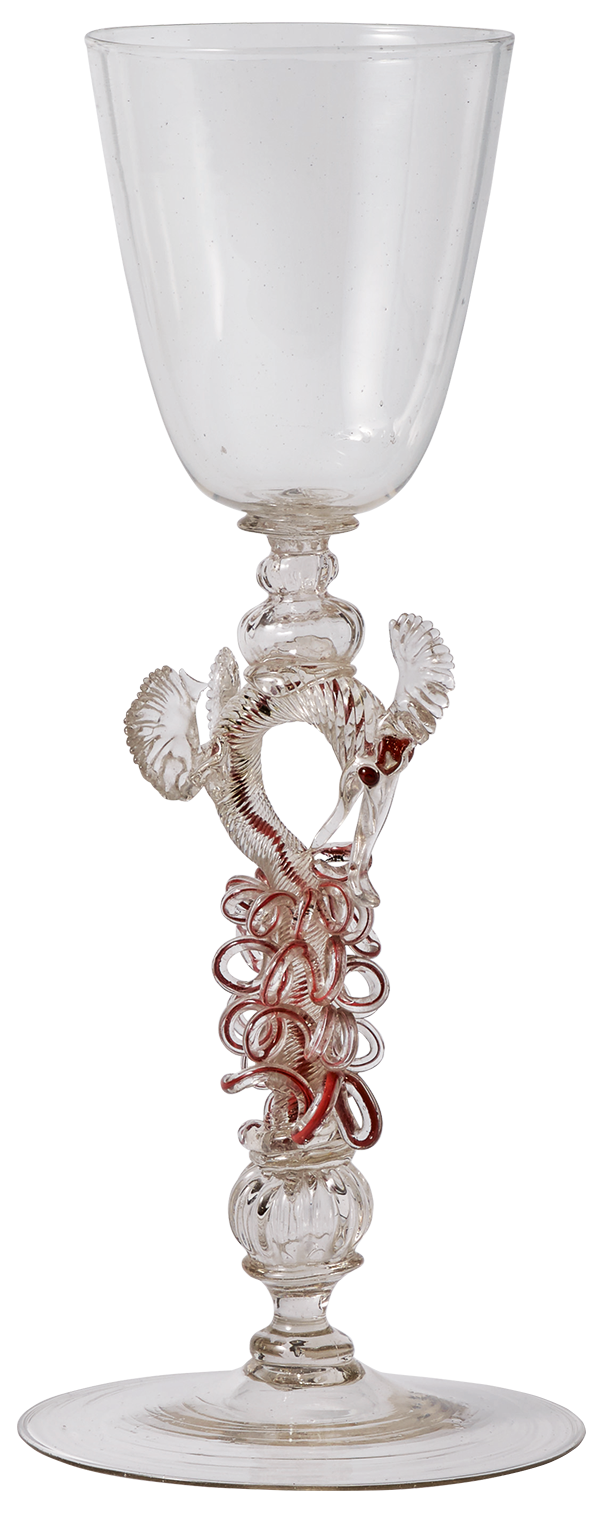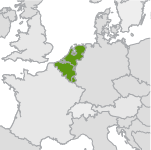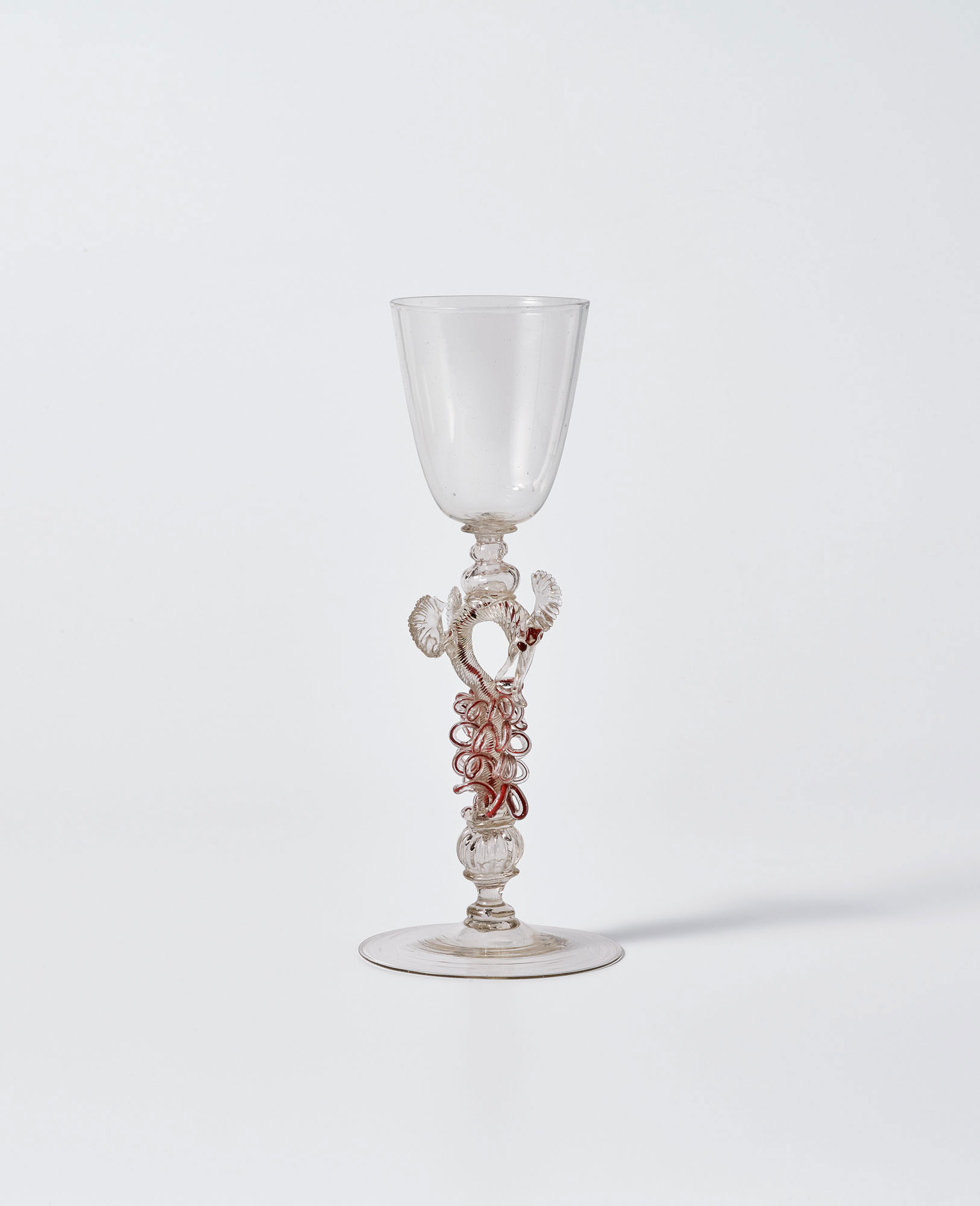Red dragon
Red Dragon
The video shows the three parts—cup, dragon, and foot being made, then kept hot in an oven in readiness for assembly. The parts are joined using small amounts of glass freshly gathered from the furnace (‘glue bits’).
Transcript
This dragon goblet is made in three parts. First the cup is made, then the foot is made. The dragon is made, and finally, using teeny bits of hot glass, the parts are joined. A moderate-sized gather of glass is made on the end of a metal blowpipe. Gathering the glass is a little like gathering honey on the end of a chopstick. The glass is rolled back and forth on the metal table (called the marver) and the purpose of this is to make the glass perfectly round and concentric with the blowpipe. Blowing begins and a bubble emerges. It's essential that the tip of the bubble be kept thicker than the sides, so glass is left thick and the tip is rolled back and forth on the marver. Using pincers, a teeny point is pulled out. The gather is elongated a bit. A constriction is begun near the blowpipe. And blowing (using a rubber hose that's off view) continues while the tip is pulled outward. This gives the cup its basic shape. Excess glass on the end is trimmed away. The neck is further refined in shape, and after a brief reheat, the lower half of the cup is given its final shape. A tiny bit of hot glass (freshly gathered from the furnace) is attached to the tip of the cup, flattened with the jacks, and then tooled using the two blades. This is creating a fixture called a merese.
A tiny amount of glass is gathered on a second blowpipe. The glass is marvered quickly. This keeps the glass very hot. A bubble is immediately blown into the glass. The bubble is tapered slightly, and after a reheat, lowered into a dip mold (or an optic mold) to create the ribs. This is lowered onto the tip of the merese, and they immediately stick together. This will form a decorative knop. Constrictions are made. At the tip a very narrow constriction is made, and it's here that the excess glass will be broken away.
In order to finish the rim, a punty (or pontil) is added to the tip, and the neck is broken. The punty is simply a handle with which the glassblower can reheat the open end and give it its final shape. The rims of goblets from this period are exceedingly thin and this is a special lip-thinning procedure. The excess glass is knocked off, and it's that glass that was the thickest. The hole is dilated and reheated with the soffietta (or puffer) used to reshape the uppermost part of the glass. And with reheats and toolings, the upper third or so of the glass is given a slightly curving profile. This is broken free of the punty and placed in the annealing oven on hold.
Next, the foot is made. It begins just like the knop that was attached to the cup. A small bubble is tooled to become a tiny oblate spheroid. A bit of glass is added. This is tooled to become another of merese. Another bit of glass is added and flattened, constricted, and pulled outward. And this will form the construction often referred to as an avolio. It's the spool-like structure that joins the foot and the knop. Here, a bubble has been added from above, attached to the end of the avolio, cut free of its blowpipe, and tooling begins to make a constriction. The constriction is held with the diamond shears. The pincers are used to tap off the excess, and this leaves a hole. And after reheating, this is dilated, inflated with the soffietta, and after another reheat, the foot is flared open. At the constriction nearest the blowpipe, the foot is broken free of its blowpipe.
A gather of glass (freshly made from the furnace) has attached to either side a red strip of glass—a cane. As marvering continues, blowing begins to inflate the glass. After the glass hardens, it's thinly overlaid with more clear glass. This is lowered into the dip mold (or optic mold) and blown. The body of the dragon is hollow, and this is pulled and twisted to form a long tube. This will be the vertical portion of the dragon body. The tip is trimmed. Another gather of glass is made on the end of a metal rod. It too has red stripes. It's attached to the tip of the tube, cut free of its gathering iron, held with pincers, and then a long metal rod (a mandrel) is held, and it's around this that the coil is created. The coil is reheated and wrapped upon the vertical tube. A tiny bit of glass is added to the tip of the tube. This will be a little seat for the foot to sit on. This is attached to a punty. The tube is broken free of the blowpipe and reheated. When the glass is soft, the upper part of the tube is shaped into the neck of the dragon. A tiny bit of glass is added at the tip, cast off, and pincers are used to make a constriction, flatten the glass, make two grooves and then at their tips pull the lips outward and down. Tiny bits of red glass are added for the eyes. A tiny bit of hot glass is added. This will become the first wing. Using a small pair of shears, tiny cuts are made to simulate the feathers. This is repeated for the second wing. The dragon is placed on hold in the annealing oven.
Next, the assembly begins. This starts with attaching the foot to a punty. And after the punty stiffens sufficiently, a tiny bit of molten glass is added to the tip of the knop. The dragon is picked up with pincers and stuck on. After another bit is added to the top of the dragon head, the cup is stuck on. The entire construction is flashed in the furnace to ensure that everything is the same temperature. And while the uppermost glue bit is still hot, a final straightening is carried out. The finished object is flashed in the furnace, and after a pause it's placed in the annealing oven for slow cooling. With a tiny tap of the punty, it breaks free of the foot.
See all: Browse by Map


